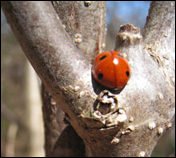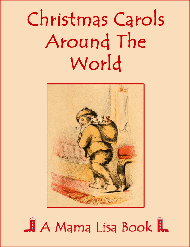What are the names for ladybugs in your language?
Ladybugs belong to the Coccinellidae family, from a Latin word meaning "scarlet". But they also have many other names: in English, they’ve been called ladybug, ladybird, lady beetle, lady clock, lady cow and lady fly.
The name ladybird was originally "Our Lady’s bird" in England. This name referred to the fact that the ladybug is red and so was the Virgin Mary’s dress when pictured in the Middle Ages. Also, the most common ladybug has seven spots and there are the Seven Joys and the Seven Sorrows of Mary. In Spanish, ladybugs are called mariquita, meaning little Mary. In German "Marienkäfer" – Mary’s bug. All those names are related to the Virgin Mary.
Ladybugs have other names related to cows or hens. We were working lately on a Swedish rhyme that goes…
Guld-höna, guld-ko!
Flyg öster, flyg vester,
Dit du flyger der bor din älskade!Gold-hen, gold-cow!
Fly east, fly west,
You’ll fly to where your sweetheart lives.
"Guld-höna" and "guld-ko" is literally "gold-hen" and "gold-cow" in Swedish. In English, the creature is sometimes referred to as "lady cow". In the Occitan language of the troubadours, there’s "galineta" (little hen) and "buòu de Nòstre Sénher" (Our Lord’s ox). In French, there’s "poulette de la Madone" (Our Lady’s little hen) and "vache à Dieu" (God’s cow).
Many centuries ago, people seem to have related the seven spots on ladybugs to the seven brightest stars of the Pleiades or Seven Sisters in the constellation of Taurus (the Bull). The Pleiades have different vernacular names related to hens. In French there’s the term "la Poussinière" (the Chicks House). In Italian, they’d say "le Gallinelle" (the Little Hens) or "la Chioccietta" (the Little Broody Hen). That’s the relation between ladybugs and hens.
Whatever name they get, they seem to bring luck. So what are the names for the ladybug in your language and are there any rhymes about this sweet little creature in your country? Please let us know in the comments below!
Written by Monique Palomares, who works with Mama Lisa on the French and Spanish versions of Mama Lisa’s World.
This article was posted on Tuesday, May 24th, 2011 at 10:59 am and is filed under Countries & Cultures, England, English, English Nursery Rhymes, French, German, Ladybird, Ladybug Rhymes, Languages, Names for Ladybugs, Nursery Rhymes, Occitan, Spanish, Swedish, Swedish Nursery Rhymes. You can follow any responses to this entry through the RSS 2.0 feed. You can skip to the end and leave a response. Pinging is currently not allowed.


























May 26th, 2011 at 7:18 pm
Here are some comments I got about ladybugs:
Purabi Khisa Tandra (from Bangladesh): “So much information! Thanks Lisa! In Bengali it is called ‘GOOBRE POKA’. I have not found a meaning for ‘goobre’, ‘poka’ means an insect.”
Ernestine Shargool Montgomerie “The Italian is ‘coccinella’ (from Latin ‘coccineus’, meaning scarlet-coloured).”
Ay Gül: “Uğur böceği in Turkish! (Uğur: Fortune, Böcek: Insect, so it means ‘the insect of fortune’). We have a short kids song for that insect! ‘Uç uç böceğim, annem sana terlik pabuç alacak.’ (Fly, fly, my little insect, my mother will buy you slipper and shoe.)”
Lauren Kent: “In south africa in english they are called ladybirds. In afrikaans i dont know and in the other 9 languages… Well a ladybird is not indigenous to RSA so there isn’t a word for them. In peace!”
Oscar: “Hi there, how are you? Greetings and salutations. I saw your posting about lady bugs yesterday. Most Spanish people call them ‘mariquitas’… But in Uruguay, ladybugs are called ‘san antonios’ That is it. ”
Anne Raleigh Rees (US/UK): “Ladybird… I grew up in NY, and did call it a ladybug…but I lived in the UK when my kids were born and re learned everything- nappies, pram, etc- plus we moved to Moscow when they were little, so I got a whole new perspective on what sounds animals make….not the same in every country….love that!”
May 27th, 2011 at 5:08 pm
Lyndsey Haezebrouck wrote:
“In Dutch it is a ‘Lieveheersbeestje’ which means – translated word for word – ‘a sweet Lord’s animal/little creature’. In my dialect we say ‘pimpampoentje’ or ‘pipow’ as well, which have no meaning really. As kids we used to say that the ones with two dots lived in the houses and the ones with more dots were the ones that lived outside.”
May 28th, 2011 at 3:53 am
In Catalan it’s called “marieta” (little Mary)
May 28th, 2011 at 8:22 am
Lin Fdln wrote: “’Kumbang Kepik’ or ‘Kumbang Koksi’ (Indonesian language).”
June 2nd, 2011 at 8:42 pm
I found the following in “Salopian shreds and patches” from 1875 talking about ladybugs:
“Guldvoyel or gold-bird is the common name in Germany…
‘Cow’ is also used in Brittany, where the children sometimes call the little insect ‘la petite vache du bon Dieu.’ It is, perhaps, worth noticing that the peasantry of some of the northern European countries attach great importance to the number of spots on the Ladycow, few spots being looked upon as foretelling a good harvest time, while if the number exceeds seven (a mystic number in all countries) it denotes a bad agricultural year. Doubtless, the name remains in England as it was introduced by some of our Scandinavian ancestors.”
June 7th, 2011 at 7:50 pm
Kapoentje is a Dutch word for ladybug.
June 21st, 2011 at 11:56 am
Why are we talking about lady bird or lady bugs
June 23rd, 2011 at 8:59 am
Because we’re looking for ladybug rhymes and songs from around the world!
September 18th, 2011 at 4:20 am
Réellement sympa tout cela !
November 15th, 2011 at 8:56 pm
Joaninha! (Little Joana)
in Portuguese (at least in Brazil)
December 19th, 2011 at 7:38 pm
En grec on l’ appelle ”pashalitsa”, nom relie aux Paques, ”Pasha” pour les grecs.
Voila la chanson que les petits chantent quand ils voient ce jolie incecte:
”envole, envole pashalitsa
pour m’ apporter des chaussures
et de beux vetements”
December 19th, 2011 at 7:44 pm
Heleni wrote (above):
In Greek it is called “pashalitsa”, a name linked to Easter, “Pasha” to the Greeks.
Here is the song that the little sing when they see this pretty insect:
“Fly, fly pashalitsa
to bring me shoes
and pretty clothes.”
December 20th, 2011 at 2:56 am
Heleni, could you please give us the Greek version of this ditty?
January 10th, 2012 at 3:57 pm
Persian goes with “Kafshdoozak”, Meaning the tiny shoemaker!
I have no idea why! :)
January 10th, 2012 at 3:57 pm
Persian goes with “Kafshdoozak”, Meaning the tiny shoemaker!
I have no idea why! :)
January 10th, 2012 at 6:58 pm
That’s neat Maryam!
April 30th, 2012 at 10:07 am
Hallo to all,
in Germany I knowthe names: “Siebenpunkt”, oder “Glückskäfer”, oder “Marienkäfer”.
Translated word by word: “Seven point”, or “fortune bug” or “Mary’s bug”
and find it as symbol for luck on birthday presents, New Year Cards
and glued to the dashboard of a car.
Greetings
Ulrich
May 6th, 2012 at 8:39 am
In Hindi a ladybug is sonapankhi, or golden wings. I’ve also been told that it is often referred to as ” pass/ fail.” In India. If a ladybug alights on your hand and stays long enough for you to count the spots you pass the exam and if it flies away without allowing you to count the spots… you fail.
May 6th, 2012 at 8:49 am
In Hindi a lady bug is sonapankhi, or golden wings. It is often referred to as “pass/fail” in India. if a ladybug alights on your hand and stays there long enough for you to count the spots you pass the exam and if it flies away without allowing you to count the spots… you fail. In Nepal, it is called jhatey, which means round like a millstone!
September 23rd, 2012 at 5:31 pm
Dear Lisa, dear friends! Here in Russia we call ladybug “God’s little cow” (that will be Божья коровка [bozhya korovka] in Russian). We have a nice kids verse about it, which goes like this:
Божья коровка, улети на небо, принеси мне хлеба
Черного и белого только не горелого.
That means:
Ladybug fly to the sky, bring me bread
Black and white but not burnt.
June 26th, 2013 at 8:34 am
In our youth during the 1950’s – 60’s our old aunt, who originated in North London, used to refer to “ladybirds” as “poor peggies”.
We cannot find anybody now who has heard this reference and have no idea how/where it originated?
April 21st, 2014 at 11:42 am
I’m from England growing up in Derbyshire/Nottinghamshire.We called Lady Birds Cow Ladies.
My Father was Yorkshire my Mother Stafordshire.
September 17th, 2014 at 4:23 pm
In Australia, I grew up calling them:
Lady Beetles
Lady Birds
Lady Bugs
My friend from Jordan calls them:
Abu Ali – Father of Ali
Abu Sulayman – Father of Solomon.
We have been looking for more information on the reasons for/origins of the Middle-Eastern/Jordanian common names, but we have not had much luck.
Although, I did find this site, so thanks. I hope our contribution is of interest.
I have another interesting set of common plant names that you might find amusing, I know I did – once I heard it, I have never forgotten.
The is a common garden plant called Impatiens or Balsam. I always heard them referred to as a ‘Busy Lizzie’. Many years ago I was in my garden talking to an Italian woman. She said she grew the same plant back in Italy. I asked her “what do you call this plant in Italy?” Her reply – “Oh, we call those ‘Busy Marias’!!”
I thought that was just awesome, it got me thinking about what other countries called the same plant – especially fun making some up – if you choose a countries most stereotypical girls name :)
Anyway, I digress – thanks again for all the wonderful information on these little spotted creatures. Much appreciated. Eve
September 17th, 2014 at 4:28 pm
Trying to add my website address
January 7th, 2015 at 11:14 pm
[…] szerencsebogárnak is. A török alapszó uğur böceği, szerencsebogár. Tekintsünk még át pár érdekesebb szóformálást. A holland szó lieveheersbeestje, az Édesúr állatkája. Brazíliában Joaninhának (Jankának) […]
October 12th, 2015 at 8:40 am
In Norfolk UK a lady bird is called a bishy barney bee. The name may be derived from the red cloak worn by a bishop Barnabas or from the “bloody bishop” who killed many Protestants or from the red cloak worn by the Virgin Mary in some mediaeval pictures of her. All of these derivations are open to question.
When I was a child if you got a lady bird on your hand you would say:
Bishy bishy barney bee
Tell me when your wedding be
If it be tomorrow day
Take your wings and fly away.
Fly to the east, fly to the west,
Fly to the one I love the best.
The other English rhyme is:
Ladybird, ladybird fly away home,
Your house is on fire and your children are gone.
Not quite such pleasant associations!
April 21st, 2016 at 11:27 pm
[…] Beetle.” As for Russia, they refer to their ladybugs as “Bozhya korovka,” meaning “God’s little […]
May 21st, 2018 at 12:53 am
Here is what the ladybug stands for in France : it brings good luck, it’s a messenger of God.
Link : http://coccinelle-et-coquelicot.com/la-minute-culturelle/coccinelles/la-legende-de-la-coccinelle/
Translation :
The little nickname of the ladybug is ” beast of the good god” because she would be a divine messenger; she would predict time (if she does not fly away from your hand it is a sign of bad weather ahead), she would bring happiness and in addition it helps gardening to fight against aphids in organic farming or reasoned.
The legend of the Xth century:
A man accused of murder is sentenced to death. He protests his innocence in vain and the executioner is about to cut his head with its his ax when he sees a ladybug on the condemned man’s neck.
The executioner gently removes the ladybug and grabs his ax to work but the ladybug is back. Although the executioner may insist on moving it, the ladybug stubbornly returns to rest on the condemned man’s neck.
So much so that the king sees there a divine miracle and gives his grace.
Some time later the real murderer was discovered and the legend of the beast to God was born
January 30th, 2019 at 4:06 am
these names weren’t good enough for my dead ladybug
October 29th, 2019 at 6:26 pm
In Irish it is called bóín Dé, or “little cow of God”. Same as the Russian.
July 8th, 2020 at 5:05 pm
Hi, love this But I clicked on this looking for a name for my ladybug 🐞.Do anyone have a good name? But my pome is like this:lady bug fly, fly far away, prig me put something good!
April 30th, 2021 at 1:04 am
I always knew the lady bug in Germany by the name of Juni Kaefer (June Bug). I guess they come out mostly in the month of June. The name “Marien Kaefer” sounds familiar also. Both of them bring good luck.
November 7th, 2021 at 6:05 am
It’s “biedronka” in polish. And it doesn’t mean anything, just a name for an insect.
Cheers from Poland,
Piotr
October 23rd, 2022 at 12:45 pm
The oldest English name for this insect family is not ‘Ladybird’ but ‘Ladycow’ according to the OED. The latter name is observed in several Tudor sources, including one dating from 1584.
Ladybird was first recorded 1597, but in the sense of ‘a lover, girlfriend’ and was first used in Shakespeare’s ‘Romeo and Juliet’ in that sense. In the insect sense it occurs in John Ray’s “A collection of English words, not generally used” (1673), where he writes “The little spotted beetle commonly called the Lady cow, or Lady-bird.”